Kit Palmer | May 19, 2016
We can sense the tone in everyone’s voices, tweets and letters. You’re really tired of hearing about Honda’s all-new Africa Twin; you just want to ride it! And perhaps even more importantly, know when you’re going to be able to get your grubby little adventurous hands on one!
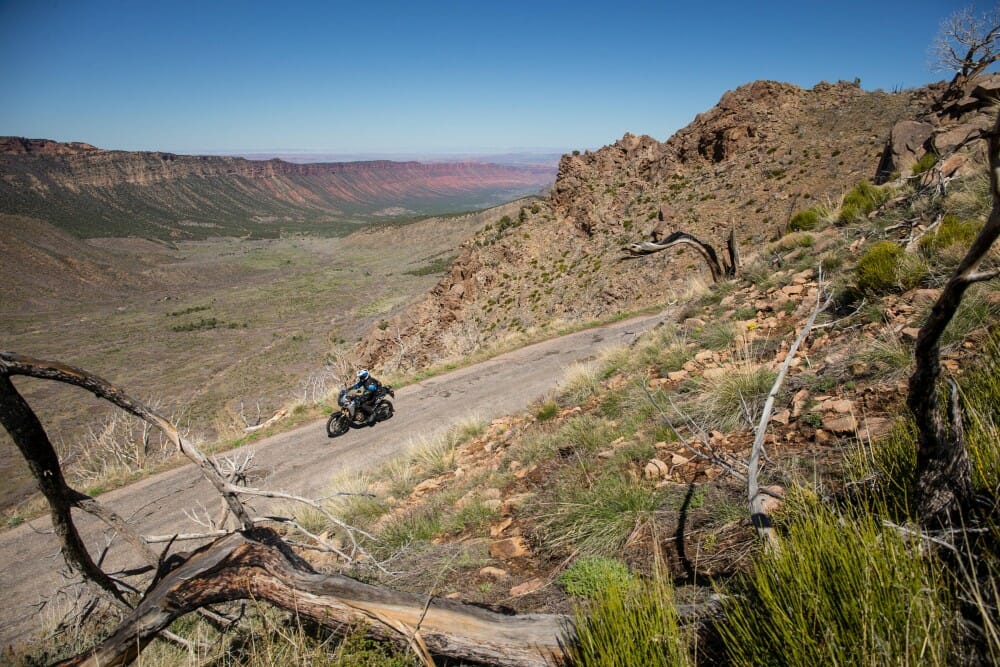
After all, the Africa Twin was announced almost two years to the day and you want to ride it. Well, you’re not the only one. Just like you, we’ve been dying to throw our legs over it, too, and we finally got our chance last week in Moab, Utah, where Honda chose to let, for the first time in this country, the media loose on what is arguably one of the most highly anticipated motorcycle (at least from Honda) to hit American soil in a long, long time.
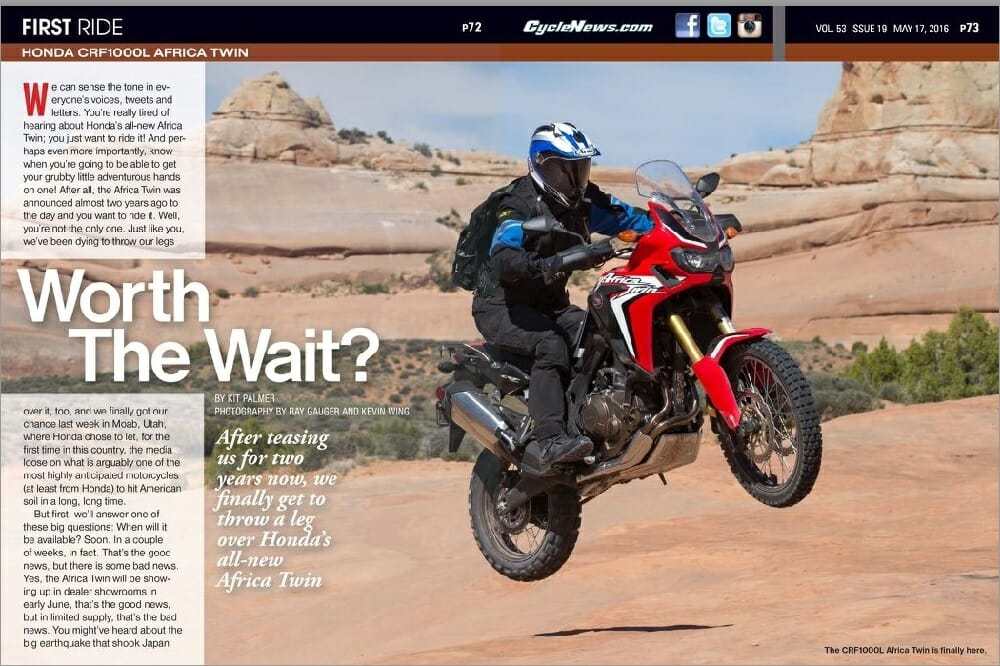
To read this in Cycle News Digital Edition Magazine, click HERE.
PHOTOGRAPHY BY RAY GAUGER AND KEVIN WING
But first, we’ll answer one of these big questions: When will it be available? Soon. In a couple of weeks, in fact. That’s the good news, but there is some bad news. Yes, the Africa Twin will be showing up in dealer showrooms in early June, that’s the good news, but in limited supply, that’s the bad news. You might’ve heard about the big earthquake that shook Japan recently, well, the quake was centered near the city of Kumamoto, where Honda has one of its major factories, the one where the Africa Twin is built. The quake forced the plant to shut down for a while and is just now ramping back up again but, unfortunately, won’t reach full production for at least another month or two. Honda says it will try and supply every dealer with at least one Africa Twin when the bike is first released. This means some of you who have already decided you got to have one will have to wait just a little longer. But don’t worry, we can tell you right now that it will be well worth the wait. Just hang in there.
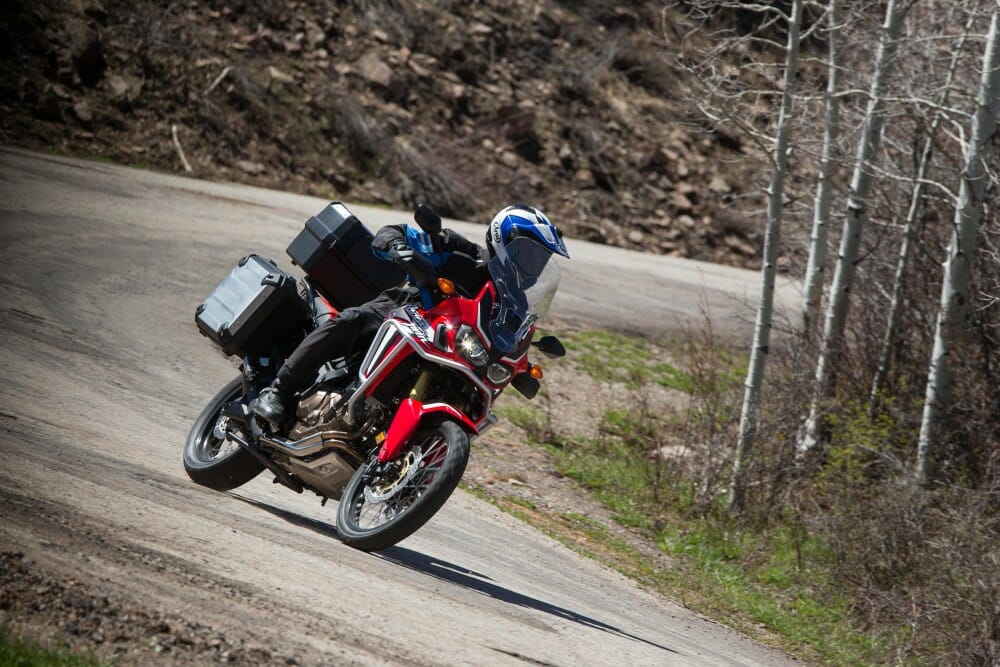 The CRF1000L Africa Twin is finally here.
The CRF1000L Africa Twin is finally here.
Real Quick, Tech Stuff
First, a little bit of history. The Africa Twin made its debut as the XRV650 Africa Twin in 1989 after winning the Dakar Rally four straight years; unfortunately, the bike never made its way to the U.S. The closest thing we ever got was the XL600V TransAlp in the early 1990s. Unlike in Europe, we hadn’t caught on to what we now call Adventure riding and the TransAlp quietly disappeared. But with the recent surge of interest in Dakar and other new rallies across the planet, Honda has shown newfound interest in adventure riding and rally competition. And because of this, we’re the lucky recipients of the new and high-tech CRF1000L Africa Twin.
Mechanically, there is tons to talk about when it comes to the Africa Twin, way too much stuff to try and attack it all here, so we’ll hit just some of the key things that make the AT (Africa Twin) tick. After all, you probably already know all about it by now.
You might’ve noticed that the AT bares the same CRF signature as Honda’s motocross bikes (like the CRF250 and CRF450R), and that is by no means a coincident, since the Africa Twin’s 998cc parallel-twin, 8-valve, water-cooled engine draws heavily from its MX cousins, most notably its four-valve Unicam head design. This single-cam system is lighter and more compact than traditional dual-cam engines since there are fewer parts. (In the AT’s case, each cylinder fires twin spark plugs.) Its six-speed transmission also uses the same shift-cam design as used in the CRF motocrossers. Unlike the MXers, though, the AT has a slipper clutch.
Another unique design of the AF’s motor is that the water pump is housed inside the clutch case. The advantage? Shorter water passages and reduced weight. The oil tank is also located inside the crankcase, which allows for increased ground clearance.
The engine is held in a steel semi-double cradle frame that has been designed with mass centralization in mind; for example, the battery and the ABS unit are packaged at the rear of the cylinder that helps contributes to a low center of gravity.
Fully adjustable Showa components offering well over eight inches of wheel travel handle suspension duties front and rear, and the bike rolls on 21-inch (front) and 18-inch (rear) wheels, just like “real” dirt bikes do. There are large 310mm wave-style floating dual Nissin four-piston disc brakes up front, and a single 265mm disc with a dual-piston caliper in the back. Both brakes utilize ABS, of course.
 We’re glad Honda chose to fit the Africa Twin with a 21-inch front wheel, which helps give the bike better controllability in the dirt.
We’re glad Honda chose to fit the Africa Twin with a 21-inch front wheel, which helps give the bike better controllability in the dirt.
The bike is also fitted with a fixed windscreen, hand guards, dual headlights, and a large 4.96-gallon fuel tank.
But the really fun part about the new Africa Twin is its electronics package and Honda’s Dual Clutch Transmission (DCT) option. The AT is available with a manual six-speed transmission or a DCT transmission, which is already found on many other Honda street models. It’s your choice. In a nutshell, DCT is basically an automatic transmission; it can do all of the shifting for you and there are no clutch or shift levers to mess with. There is, however, many ways of configuring the DCT actions—mainly shift points—and you can even set it in manual mode where you get to decide when to change gears via “flippers,” or “triggers,” on the left handlebar. We’ll get more into all this in a bit.
Two color options are available—Red/Black/White Dakar Rally (way cool!) and Silver (mmm, kind of boring by comparison but still looks nice). Both color versions will be available for either the manual or DCT bikes.
 The Africa Twin is also offered in silver beside the now more familiar red, white and black color scheme. You also have the choice between manual transmission and DCT.
The Africa Twin is also offered in silver beside the now more familiar red, white and black color scheme. You also have the choice between manual transmission and DCT.
Get To The Riding Part Already!
Honda’s first plan of action for us was a relatively short 60-plus mile pavement loop on the Africa Twin, which was a good idea in that it allowed us/me to get fully acquainted with the DCT model and all of its ride modes before tackling the more challenging 100-mile mostly dirt ride they had planned for us the following day.
For the road ride, the AT was fitted with OE Dunlop Trailmax D610 street tires; for the dirt, they were swapped out for more aggressive knobby-type Continental Twinduro TKC80 dual sport tires.
Honda also stiffened up the suspension a bit before our butts even touched the seat. (See sidebar.)
I spent an equal amount of time on both bikes, the manual transmission model and the DTC model, and discovered that both bikes are equally fun to ride, just a little different. Overall, the Africa Twin is remarkably comfortable in the seat, which is wide, low and just cushy enough. I found the AT’s 34.3-inch seat heat to be about right for my 6’1” frame; I was able to plant both my feet firmly on the ground, so I never even felt the need to try the lower 33.5-inch setting.
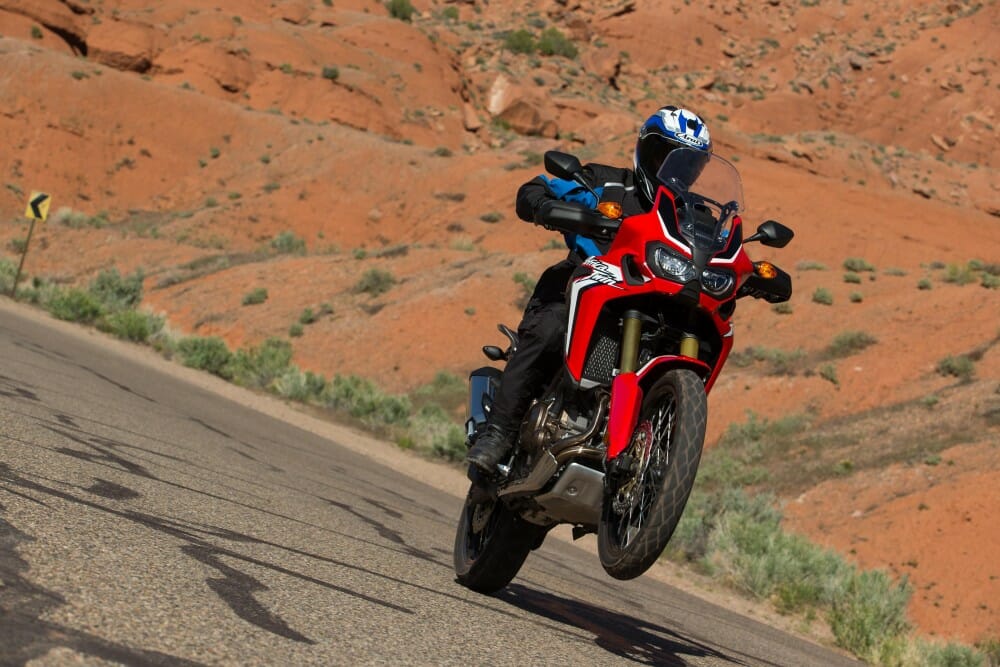 The Africa Twin is very comfortable on the pavement.
The Africa Twin is very comfortable on the pavement.
Initially, I was probably most impressed with the AT’s suspension. Even though both ends were cranked up a bit from stock, the bike still offered a cushy ride without feeling overly soft or mushy. And, as the fork and shock starting using up their travel, the ride never got harsh or jagged, just comfortably firm. Small potholes seemed to just magically disappear. At one point of our street ride, we rode a section of twisty pavement that probably hadn’t seen new asphalt since 1945. Potholes were everywhere and I was doing my best to avoid them until I realized that I didn’t have to; you could just ride right through them, straight up or leaned over, and you wouldn’t feel them! You could slam right through those suckers without a care in the world, and whatever the suspension couldn’t completely handle was soaked up nicely by the ‘Twin’s steel chassis and rubber-mounted handlebars, while never losing a tick of stability. I quickly developed a lot of trust and confidence in the AT’s suspension and chassis, and that confidence carried over onto the dirt.
The Africa Twin is not a light motorcycle. Honda’s specs list the manual model at 511 pounds and the DCT model at 534 pounds, so I was expecting an interesting ride over the ruts and some nasty bottoming on the G-outs when the pavement turned to dirt, but the suspension really surprised me again by how well it soaked it all up. It actually took pretty good smacks at speed before I could get either the fork or the shock to bottom, and when either one of them did, it wasn’t a nasty “clank,” but more of a tolerable “thud.” In other words, it didn’t hurt. Plus, the bike has excellent ground clearance; I don’t think I ever dragged the skid plate.
After a while, I felt like I could ride the Africa Twin more like a dirt bike than a street bike trying to act like a dirt bike and began upping my speed a bit, and any anxiety I might’ve had about riding the big AT on the dirt pretty much died off. Still, the CFR1000L is not a CRF450X and demands a fair amount of respect on the dirt; it’s a big bike in comparison, but the AT isn’t in any hurry to bite you back if you get tired and sloppy. It’s very forgiving, even in the soft sand. The front end, with its narrow-profile front tire, will wiggle around a bit when hard-packed turns to sand, but I’ve ridden bikes a lot worse in these conditions. Just sit back and open the throttle, which is easy to do on the Africa Twin.
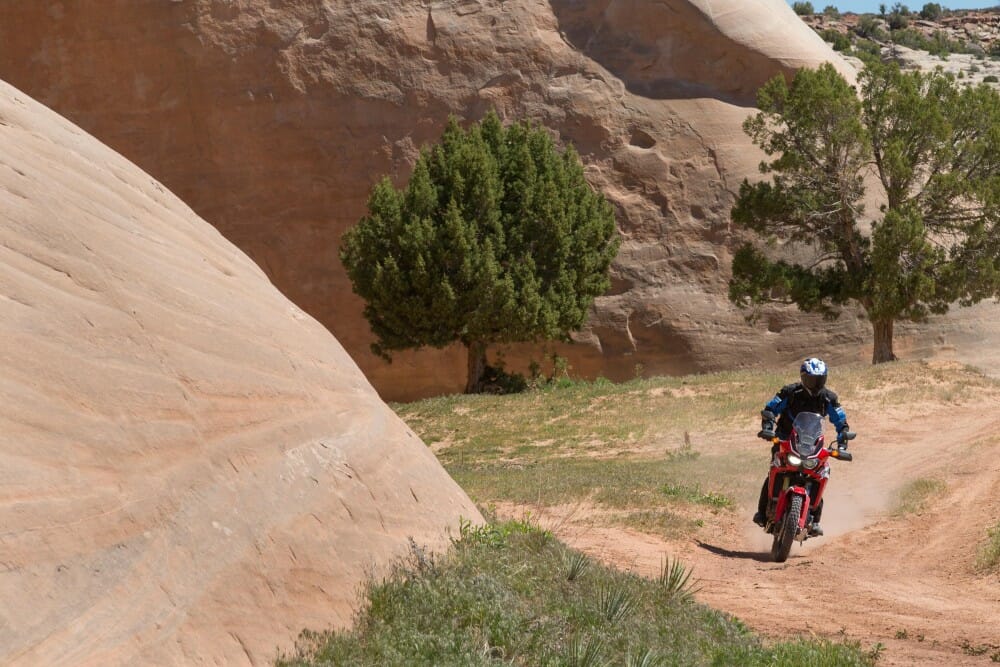 Compliant suspension and lots of ground clearance helps make the Africa Twin a very competent dirt bike.
Compliant suspension and lots of ground clearance helps make the Africa Twin a very competent dirt bike.
The engine makes plenty of smooth power. Even after having spent the last few months on the KTM 1290 Super Adventure with its incredibly powerful engine, the Honda in no way felt down in the horsepower department to me. It has great torque and pulls hard over a wide and broad powerband, and there is very little evidence of vibration. There is nothing intimidating at all about the Africa Twin’s engine, and, better yet, it sounds bitchen when you open it up. Parallel-twin motors rarely inspire me, but this one certainly does!
Manual Labor
Of the two models—manual and DCT—I preferred the manual, which probably has a lot to do with my more off-road background. However, I enjoyed the DCT ‘Twin on the street. Talking with other journalist, I got the feeling that the more off-road experienced riders generally preferred the manual over the DCT and vice versa for the less-experienced off-road riders. I liked having the clutch at my disposal whenever I needed a quick burst of power to get me out of trouble, especially over technical terrain, such as rocky climb. I saw one very experience journalist drop the DCT in one such situation; had he had a clutch lever, I’m not so sure that would’ve happened, or, on the other hand, if he had just a bit more time on the DCT. Just an observation.
Both the manual and DCT Africa Twins feature selectable torque control, which is pretty much another name for traction control. You have varying degrees of interventions (three of them) that the rider can dial in. For off-road, I preferred the third setting with the least amount of intervention, while on the pavement I actually liked the first position with the most intervention, when it immediately reacted to the slightest detection of wheel spin. Honda’s torque control system can be changed on the fly and works through the bike’s ECU by measuring rear-wheel slip via the ABS sensors; if wheel slip is detected, the ECU reduces fuel injection. Overall, I thought torque control was a great feature that worked extremely well. Whenever the bike is turned off, torque control defaults to the highest intervention. I, however, wish it would remain at your last chosen setting. You can turn torque mode completely off if you want. ABS can also be disabled via a button on the panel and while you’re not moving. However, you’re only turning the ABS off to the rear wheel, not the front. This a first for a Honda motorcycle and one that I’m beginning to like more and more as I ride more bikes with this feature. I just haven’t experienced a real reason yet not to have ABS watching my back full-time up front.
 The ‘Twin has excellent ground clearance; I don’t think I ever dragged the skid plate.
The ‘Twin has excellent ground clearance; I don’t think I ever dragged the skid plate.
The DCT AT also has “S” mode, which stands for “Sport.” S mode alters when the transmission shifts and you have three choices: levels one, two and three; level one being the least aggressive (less revvy), level three being the most. S mode can be confused with engine-mode features on other bikes, but it’s not that at all, it just changes shifting points and has nothing to do with altering the engine’s power mannerisms. (Except for the CRF250 and 450Rs, no Honda motorcycle offers engine mode.) When you turn off the DCT bike, it defaults to “Conventional” mode, so you have to push a button on the left handlebar to activate S mode every time you start the bike. This is a little annoying, because you’ll ride this bike in S mode 99.9 percent of the time because conventional mode is extremely tame and is, for all intents and purpose, “rain” mode.
 Sturdy hand guards are a nice tough. The “D-S N” button operates the S-mode options on the DCT model, you’ll use it a lot.
Sturdy hand guards are a nice tough. The “D-S N” button operates the S-mode options on the DCT model, you’ll use it a lot.
The DCT bike also has G mode, which can be easily be turned on or off on the fly. Turned on, G mode smoothens on/off throttle transition at slow speeds to help eliminate that herky-jerky feeling, a common problem with most auto bikes. I found it to come in handy on gravel (hence “G” mode) and in parking lots at walking speeds. Turned off, initial throttle response is quicker, good for off-road riding. After trying many combinations with the DCT bike off-road, I found, for me at least, that Sport-mode 3 and Torque-mode 3 (least intervention), or just turned off completely, with both ABS and G-mode turned off, as well, worked quite well in the dirt. With these setting, you could ride the bike almost like you would the manual version; I could see how DCT could be advantageous on long rides. It reduces the rider’s workload a bit and could make things easier on you when you’re tired at the end of the day.
I was, however, not a fan of Hill Detection. This senses when the bike is being ridden up or down steep grades and adapts gearshift patterns for ascents and/or descents. Uphills seemed okay, but steep downhills, when they were long enough that I actually wanted to open the throttle, the bike wouldn’t shift out of first gear and would just rev to the moon. “C’mon, shift!” I guess I could’ve manually shifted up with the manual trigger but I didn’t think about doing that until I was back at the hotel. I didn’t get a chance to ride the bike again to see if that would’ve worked. Transmission-wise, you can override everything and manually shift the DCT bike at anytime, or you can switch into full manual mode and do all of the upshifting yourself with the handlebar-mounted triggers. (It will still downshift for you even in manual mode, though.) For me, full manual mode was a lot of fun for the street but not as much for the dirt.
As mentioned, the AT is not exactly light, but for a 1000cc adventure bike, it’s not bad at all. In fact, it feels lighter than its listed 511 pounds, but you do feel the extra 20-plus pounds of the DCT bike. It’s not a huge deal but you do notice it.
All of the electronic info is strategically placed in the AT’s well-thought-out instrument panel and is easy to read, except when it’s dusty out. There are four sunken viewing planes and they do a great job of collecting dirt and dust, making it difficult to read and hard to clean. You’re constantly wiping off each one of the planes when a single clear piece of plastic covering the entire instrument panel would probably work better—one swipe and you’re all good. This and Hill Detection were pretty much my only gripes with the Africa Twin. Well, I would like to see heated grips as standard equipment.
 There is a lot of info right here, but the windows quickly fill with dust and is hard to wipe off.
There is a lot of info right here, but the windows quickly fill with dust and is hard to wipe off.
Goodies
Honda already has plenty of accessories available for the Africa Twin, such as side bags and top case, tall windscreen, low seat, heated grips, center stand and a light/crash bar. Honda has also teamed up with Spidi, Alpinestars, Arai Helmets and Klim to produce some cool riding gear designed specifically for the Africa Twin that will be sold at Honda dealerships (Klim products will be sold through both authorized Klim and Honda dealers).
 The Africa Twin all decked out with accessories.
The Africa Twin all decked out with accessories.
And, What do we Think?
I very much enjoyed riding the Africa Twin, both the manual and DCT versions. The bike is extremely comfortable, which is great for long days in the saddle, and, overall, is just plain easy to ride, even in the dirt once you get used to it. Power is exciting (except in Conventional mode) yet un-intimidating in any mode, but what probably impressed me most was it’s suspension, both on and off the road. Honda did a great job making a big bike handle well on both the dirt and pavement, which isn’t easy to do.
Yes, it’s been a long wait for the Africa Twin but at least it was worth it. CN

|
SPECIFICATIONS: 2016 Honda CRF1000L Africa Twin
|
|
MSRP:
|
$12,999 (manual)/$13,699 (DCT)
|
|
ENGINE TYPE:
|
Liquid-cooled, 4-stroke, 8-valve, parallel twin, with 270° crank
|
|
VALVTRAIN:
|
Unicam
|
|
DISPLACEMENT:
|
999cc
|
|
BORE X STROKE:
|
92.0 x 75.1mm
|
|
CLUTCH:
|
Manual: Wet, multiplate with coils springs, aluminum cam assist and slipper clutch; DCT: 2 wet multiple clutches with coil spring
|
|
TRANSMISSION:
|
Manual: Constant-mesh 6-speed; 6-speed
|
|
FINAL DRIVE:
|
O-ring sealed chain
|
|
TORQUE CONTROL:
|
3 levels adjustability plus off
|
|
FRAME:
|
Steel semi-double-cradle type with steel rear subframe
|
|
FRONT SUSPENSION:
|
Showa 45mm cartridge-type inverted telescopic fork, fully adjustable
|
|
REAR SUSPENSION:
|
Monoblock cast aluminum swingarm with Pro-Link shock, fully adjustable
|
|
FRONT WHEEL TRAVEL:
|
9 in.
|
|
REAR WHEEL TRAVEL:
|
8.4 in.
|
|
WHEELS:
|
Wire spoke with aluminum rims
|
|
FRONT RIM:
|
21 x 2.15 in.
|
|
REAR RIM:
|
18 x 4.0 in.
|
|
FRONT TIRE:
|
90/90-21 in. tube type, Dunlop Trailmax D610
|
|
REAR TIRE:
|
150/70-18 in. tube type, Dunlop Trailmax D610
|
|
FRONT BRAKE:
|
310mm dual wave floating disc w/4-piston calipers, Nissin (ABS)
|
|
REAR BRAKE:
|
256mm wave disc with 1-piston caliper, Nissin (ABS)
|
|
ABS SYSTEM:
|
2-channel with rear ABS off switch
|
|
WHEELBASE:
|
62.0 in.
|
|
SEAT HEIGHT:
|
34.3 in. standard/33.5 in. low position
|
|
GROUND CLEARANCE:
|
9.8 in.
|
|
CURB WEIGHT:
|
511 lbs (manual), 534 lbs. (DCT)
|
|
TURNING RADIUS:
|
8.5 ft.
|
|
FUEL CAPACITY:
|
4.9 gal.
|
|
COLORS:
|
Red/White/Black Dakar Rally; Silver
|
To read this in Cycle News Digital Edition Magazine, click HERE.
For more Cycle News Adventure motorcycle reviews, click HERE.
For more Honda motorcycle reviews, click HERE.